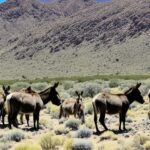Can you imagine seeing a wolf in California’s wilds? The gray wolf was common in places like the Sierra Nevada until about the 1920s. They nearly disappeared. But now, some wonder if they might be making a quiet return.
In the early 20th century, records showed the wolves were gone. However, Northern California’s vast and suitable habitats give hope for their return. These areas can provide the wolves with homes rich in diversity and the food they need, like elk and deer. The question remains: what will happen to California’s wild wolves?
Historical Presence of Wolves in California
European explorers and settlers witnessed wolves living across California’s varied landscapes. This included places from the Central Valley to the Coastal Ranges. Before large changes from European activities and hunting, California had many wolves. People knew wolves ranged from the Coast to the Sierra Nevadas from 1750 to 1900.
The arrival of Europeans in California greatly changed the land. Market hunting and changes to the land lowered the numbers of prey for wolves. This led to the wolves disappearing by the 1920s. Indigenous groups hold the memory of wolves, with many having special words and stories about them.
Historical evidence proves that wolves once lived widely, from the Coastal Ranges to the Sierra Nevadas. This history sheds light on how much the environment has changed since then.
To know the past presence of wolves in California gives value to today’s conservation efforts. By learning and remembering the role of wolves, we can work towards a future where they thrive as part of California’s wild places.
Current Wolf Populations in California
Since 2011, the OR-7 wolf has played a key role in California’s wolf conservation. Journey’s sighting was the first confirmed in 90 years. This marked a big step in the return of wolves to Northern California.
The Journey of OR-7
OR-7, also known as Journey, was a big deal for California’s wolves. He traveled from Oregon to California. It drew attention to wolves’ efforts to come back to their old homes. His journey gave new hope to those working to protect California’s wildlife.
Known Wolf Packs in Northern California
Since Journey’s arrival, we now know of seven wolf packs in Northern California. This includes OR-7’s Lassen pack, which is doing well. His son, CA-08M, leads this pack, showing success in wolf recovery efforts.
| Wolf Pack | Established Year | Significant Members |
|---|---|---|
| Lassen | 2017 | CA-08M (son of OR-7) |
| Beckwourth | 2019 | Unknown |
| Whaleback | 2020 | Unknown |
| Beyem Seyo | 2021 | Unknown |
| Harvey | 2018 | Unknown |
| Yowlumni | 2022 | Unknown |
| Unnamed Pack | 2021 | Unknown |
These growing packs are good news for California’s wolves. They show that efforts to protect and help wolf populations are working. This is a positive sign for their future in Northern California.
Western Gray Wolves in California
The comeback of Western gray wolves in California is a major win for protecting nature. These wolves can live in many places, which shows they’re tough and can adjust well. They now roam over lots of land, both owned by the public and by private people. This proves just how flexible they are and how they fit in their surroundings.
Adaptation and Habitats
The wolf adaptation and habitats in California point to them being great at living in various places. They do well in thick forests and wide-open spaces by finding what they need most: lots of animals to eat and people who are okay with them. This mix of different lands in California is perfect for the Western gray wolf to keep growing in numbers.
Primary Prey and Dietary Habits
Learning about the primary prey and dietary habits of Western gray wolves is key to helping them. They mainly eat big animals like elk and deer. Sometimes, though, they also eat dead animals or livestock. Being able to eat different things means they can handle changes in their food supply, which helps them do well in many places.
Endangered Species in California: Wolves’ Protected Status
Wolves play a key role in our ecosystems. But, their numbers have dwindled, worrying conservationists. Since 1973, the federal Endangered Species Act has shielded them. This is critical for the effort to help wolves in California stage a comeback. It’s now against the law to hurt or kill them in the state.
- The federal Endangered Species Act of 1973 started efforts to save many species, including wolves.
- Wolves are now considered an endangered species in California, stressing their urgent need for protection.
- These laws have played a huge part in helping wolves recover in places like California.
Protecting wild areas and educating the public are key steps. So is working together on research. Following the rules of the federal Endangered Species Act, people do a lot to keep wolves safe in California. They make sure the environment is good for their growth.
Thanks to these actions, we’ve seen more wolves and more stable wolf groups. Everyone’s hard work aims to grow the wolf population even further. They’re working to keep these amazing creatures around for a long time.
| Factor | Description |
|---|---|
| Federal Endangered Species Act | It sets up laws to protect at-risk species, like wolves. |
| Endangered Species in California | This label ensures wolves get the attention they need to survive. |
| Protecting California Wolves | Efforts combine legal steps, environmental care, and community help. |
Helping wolves in California get back on their feet is not easy. But, calling them an endangered species in California marked a good start. This is a strong beginning for all the work we need to do to protect them.
Are there any wild wolves in California?
Recently, wild wolves have started coming back to California. This return comes after almost a hundred years of absence. We know about their comeback thanks to many reports and scientific checks, which prove they’re back.
Recent Sightings and Reports
In 2021, people saw wolves in California. These sightings happened mostly in Northern California. The area’s a good place for them to live. The news has got wildlife fans and scientists very interested.
DNA Evidence and Tracking Techniques
Tools like DNA evidence and tracking are key in studying these wolves. Scientists find and follow them by testing things like scat and fur. This not only proves they’re there but also helps in keeping an eye on their health and how many there are.
| Year | Notable Sightings | Research Techniques |
|---|---|---|
| 2021 | Northern California; multiple pack formations | DNA sampling, GPS tracking |
| 2022 | Increase in Southern California sightings | Camera traps, DNA analysis |
| 2023 | Expansion into new territories | Satellite telemetry, fecal DNA tests |
Factors Impacting California’s Wolf Population
Wolves in California are facing threats due to human actions and changes in the environment. These challenges need to be managed to ensure wolves continue to play a role in the state’s ecosystems.

Human Activity and Habitat Fragmentation
Human activities like hunting, building roads, and farming are reducing wolf numbers. These actions break up large areas of habitat into smaller pieces. Wolves then struggle to find suitable living spaces. Also, farming practices lower the number of animals wolves can hunt, which hurts their survival.
Efforts to Mitigate Human-Wildlife Conflict
It’s vital to address the conflict between people and wolves to protect these animals. Some strategies aim to keep wolves away from places humans live and work. Using methods that don’t harm the wolves, like scare tactics, can help. So can making things fairer by offering compensation to farmers who lose animals to wolves.
| Impact Factor | Description |
|---|---|
| Hunting | Direct reduction in wolf numbers due to illegal or regulated hunting. |
| Road Construction | Creates physical barriers that fragment habitats and increase wolf mortality risk. |
| Agricultural Development | Reduces prey availability by transforming natural habitats into farmland. |
| Predator Aversion Methods | Includes non-lethal deterrents to prevent wolf-livestock conflicts. |
| Wildlife-Friendly Policies | Encourages cohabitation through compensation programs and protective legislation. |
California Wolf Conservation Efforts
Efforts to save wolves in California are making big strides. State and federal groups are working hard. They join forces with dedicated non-profits to keep wolves safe and ensure they have a great future in California’s many habitats.
State and Federal Protections
Both state and federal laws have helped a lot in protecting California wolves. The 1973 Endangered Species Act gave them federal protection, along with special California laws. These laws stop problems between people and wolves and help the wolf population grow.
Role of Conservation Organizations
Groups like California Wolf Center are essential in keeping wolves safe. They do research, teach the public, and fight for laws to help the wolves. Their work is key. It has stopped wolf hunting and allowed wolves to return to places like the Klamath-Siskiyou and Modoc Plateau.
| Aspect | State Protections | Federal Protections | Conservation Organization Efforts |
|---|---|---|---|
| Legal Status | Endangered | Endangered under ESA | Advocacy and Policy Work |
| Key Legislation | California Endangered Species Act | Endangered Species Act of 1973 | Education and Public Awareness |
| Primary Goals | Protection and Recovery | Protection and Recovery | Research and Monitoring |
Gray Wolves and the Ecosystem
Gray wolves in California are vital for ecosystem balance. They keep prey numbers in check, aiding in biodiversity and habitat health. These predators impact deer and elk behavior, which benefits plant growth.
“Gray wolves are essential for maintaining dynamic and healthy ecosystems.”
Efforts for California wildlife conservation highlight the role of gray wolves. They cause a chain reaction of good effects, leading to more plants and the improved health of riparian zones.
Conservation groups in California work hard to raise awareness about wolves. They also conduct studies showing how wolves influence their environment. This knowledge is crucial for managing and protecting wildlife.
| Benefit | Impact on Ecosystem |
|---|---|
| Prey Regulation | Helps control populations of herbivores, preventing overgrazing. |
| Biodiversity | Promotes a variety of plant and animal species by supporting trophic cascades. |
| Riparian Health | Leads to the recovery of vegetation along streams and rivers, enhancing water quality. |
Gray wolves in California show the deep connections in nature. They are key to making sure habitats thrive for future generations. This work is essential for wildlife conservation in the state.
How You Can Help Support Wolves in California
Helping California wolves is simpler than you imagine. You can make a big difference by joining in educational activities. These are often led by groups like the California Wolf Center. They teach us a lot about wolf biology, behavior, and their need for conservation. By learning and sharing this knowledge, you can help others understand and support these efforts.
Another way to help is by going to nature centers and wildlife reserves. These visits support places that work hard to protect wolves. You also get to see these amazing creatures up close in their habitats. It makes you more committed to helping them and appreciating the work done to protect them.
Volunteering is also a great way to support wolf conservation. Many projects are in need of volunteers for various tasks. Your work can really help ensure a better future for California wolves. Also, think about giving a donation to places like the California Wolf Center. Any financial help you can offer goes a long way in supporting their work for wolf recovery and other wildlife causes.
FAQ
Are there any wild wolves in California?
Yes, there are wild wolves in California. The journey of the wolf OR-7 in 2011 set things off. Since then, many wolf packs have made Northern California their home.
What is the historical presence of wolves in California?
Gray wolves were once all over California. This included the Sierra Nevada and Coastal Ranges. Sadly, they mostly vanished by the 1920s. This was due to changes in where they could live and being hunted.
Who was OR-7?
Also called “Journey,” OR-7 was a landmark for wolf conservation. He became the first verified wild wolf in California since the 1920s. Journey arrived in 2011, making his mark on the state.
What are the known wolf packs in Northern California?
Northern California is home to at least seven wolf packs. These include Lassen, Beckwourth, and others. Knowing these packs exist shows that efforts to save wolves are working well.
How do Western gray wolves adapt to their habitats in California?
These gray wolves are great in many places. They fit right in the mix of public and private lands in Northern California. They just need plenty of food and for people to be okay with them.
What is the primary prey and dietary habits of wolves in California?
Wolves in California mostly eat big animals like elk and deer. They will also eat already dead animals and sometimes take livestock.
Are wolves in California considered an endangered species?
Yes, California’s wolves are on the endangered list. Both federal and state laws protect them. These laws aim to help the wolves survive and grow in number.
How do recent sightings and reports contribute to understanding wolf populations in California?
Learning about where wolves are through lookouts and new science is helping a lot. With this information, we know more about the wolves in California. We see they are doing well and even increasing in number.
What human activities impact the wolf population in California?
Things like hunting, building roads, and farming can hurt wolf numbers. They make the places wolves live smaller and take away their food. We’re trying to help the wolves by stopping these harmful actions.
What efforts are in place to protect wolves in California?
We’re working hard to protect the state’s wolves. Laws help shield them, and many groups are working to help them live safely. The California Wolf Center is a key player in these efforts.
How do gray wolves influence the ecosystem in California?
Gray wolves are very important for keeping nature balanced. They affect what their prey does and keep the food chain working right. This is good for the many different plants and animals that live there.
How can you help support wolves in California?
Help wolves by learning about them, giving your time, sending money to groups that protect them, and telling others about how important wolves are. This makes a big difference in their survival.







